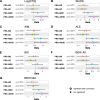Polygenic risk scores for severe psychiatric disorders in bipolar disorders: associations with the clinical and dimensional expression, interactions with childhood maltreatment and mediation models
- PMID: 40715078
- PMCID: PMC12297605
- DOI: 10.1038/s41398-025-03466-5
Polygenic risk scores for severe psychiatric disorders in bipolar disorders: associations with the clinical and dimensional expression, interactions with childhood maltreatment and mediation models
Abstract
Polygenic risk scores (PRSs) for several psychiatric disorders have been associated with the clinical presentation of bipolar disorder (BD). PRSs have also been suggested to moderate the associations between childhood maltreatment and BD severity. In this study, we investigated how PRSs for BD, schizophrenia, major depressive disorders (MDD) and attention-deficit/hyperactivity disorder (ADHD) might disentangle the clinical and dimensional heterogeneity of BD in a sample of 852 affected individuals. We used logistic and linear regressions, moderation and mediation models to test the associations between PRSs, dimensions in childhood/adulthood and clinical indicators of severity of BD. All models were adjusted for age, sex, BD type and depressive symptoms. None of the PRSs were significantly associated with the clinical expression of BD when considered in terms of mode of onset, course, or psychiatric comorbidities. Nevertheless, the PRS-ADHD significantly and positively correlated with the levels of childhood maltreatment, childhood ADHD symptoms, and of some adulthood measures (affective lability, impulsivity and hostility) with p values ranging from 3.10-8-4.10-4. None of the PRSs moderated the effects of childhood maltreatment on the clinical or dimensional variables. Mediation model suggested paths from both PRS-ADHD and PRS-MDD to childhood ADHD symptoms and childhood maltreatment. The links between PRS-ADHD to all adulthood dimensions were mediated by childhood ADHD symptoms (p < 0.002). In turn, some adulthood dimensions (mainly affect intensity and affective lability) were associated with the clinical severity of BD, as defined by rapid cycling, suicide attempts and anxiety disorders. In conclusion, this study disentangles the associations between the genetic liability for four psychiatric disorders and the clinical/dimensional heterogeneity of BD. We suggest a continuum from the genetic risk for ADHD and MDD through dimensions in childhood/adulthood to a severe/complex clinical expression of BD.
© 2025. The Author(s).
Conflict of interest statement
Competing interests: The authors declare no competing interests. Ethics approval and consent to participate: All methods were performed in accordance with the relevant guidelines and regulations. informed consent was obtained from all participants. The assessment protocol was approved by the institutional review boards (Comité de Protection des Personnes Ile de France V and VI). Written informed consent was obtained from all participants as part of the PsyCohBP (reference ID RCD: 2013-A01375-40) et Biobanque (reference ID RCB: 2013-A01286-39) research protocols.
Figures


References
MeSH terms
Grants and funding
- ANR-11-IDEX-0004-02/Agence Nationale de la Recherche (French National Research Agency)
- ANR-10-COHO-10-01/Agence Nationale de la Recherche (French National Research Agency)
- ANR-11-IDEX-0004-02/Agence Nationale de la Recherche (French National Research Agency)
- ANR-10-COHO-10-01/Agence Nationale de la Recherche (French National Research Agency)
- ANR-10-COHO-10-01/Agence Nationale de la Recherche (French National Research Agency)
LinkOut - more resources
Full Text Sources
Medical

